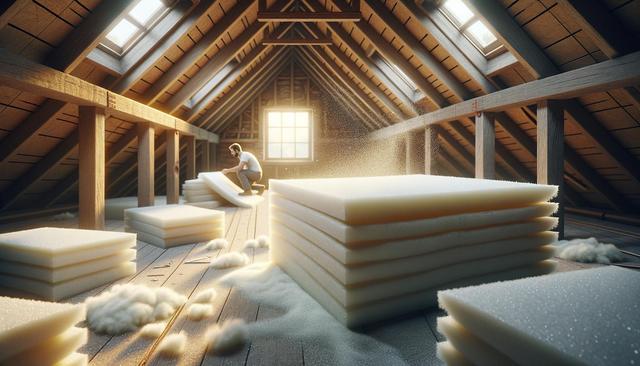Understanding Affordable Foam Insulation Options
When it comes to insulating your home, choosing the right material can make a noticeable difference in both comfort and energy bills. Affordable foam insulation has become a popular choice for homeowners looking for effective thermal performance without exceeding their budget. This type of insulation includes a variety of foam-based materials that can be applied in different ways depending on the structure and needs of the building. Spray foam insulation, in particular, is widely used for its ability to create an airtight seal and prevent air leakage.
Two common types of foam insulation are open-cell and closed cell spray foam. Open-cell is generally lighter and more affordable, while closed cell spray foam offers superior density and moisture resistance. Both options contribute to a more energy-efficient home, but choosing the right one depends on the specific application and climate zone.
When considering affordability, it’s essential to balance upfront costs with long-term energy savings. Foam insulation may have a higher initial price tag compared to traditional materials, but its performance often leads to reduced heating and cooling expenses over time.
Benefits of Spray Foam Insulation
Spray foam insulation offers several advantages that make it a practical solution for many homeowners. Its ability to expand and fill gaps ensures a tight seal, which can significantly reduce drafts and energy loss. This contributes to lower utility bills and a more stable indoor temperature year-round.
Some key benefits include:
- Superior thermal resistance (R-value)
- Air and moisture barrier
- Improved indoor air quality
- Durability and longevity
Closed cell spray foam, for example, adds structural integrity to walls and roofs due to its rigidity, making it a dual-purpose investment. Although the spray insulation cost may seem higher initially, these long-term benefits often justify the expense, especially in areas where energy costs are high.
In addition to energy savings, spray foam insulation helps minimize allergens and pollutants by sealing off entry points. This can be particularly beneficial for households with individuals who suffer from allergies or respiratory conditions.
Comparing Spray Insulation Cost with Other Materials
Understanding the spray insulation cost in comparison to traditional materials like fiberglass or cellulose is key to making an informed decision. While foam insulation typically demands a higher upfront investment, it often results in greater long-term savings due to its performance and lifespan.
Here’s a general breakdown of how spray foam compares:
- Installation: More complex, often requiring professional service
- Performance: Higher R-value and air sealing capacity
- Longevity: Can last for decades without degrading
- Return on investment: High in climates with extreme temperatures
Injection foam insulation is another alternative that provides similar benefits. Installed into existing walls, it’s a good option for retrofit projects where removing drywall isn’t feasible. Though slightly less expensive than spray foam, its effectiveness still makes it a competitive choice.
Ultimately, while the initial costs may be higher, the cumulative savings on energy bills and the added comfort make affordable foam insulation a wise investment for many property owners.
Why Closed Cell Spray Foam Stands Out
Closed cell spray foam distinguishes itself through its high density and moisture resistance. This type of insulation is especially beneficial in areas prone to humidity or where space is limited. Its compact nature allows it to deliver greater thermal performance in thinner applications compared to open-cell options.
Some noteworthy characteristics of closed cell spray foam include:
- High R-value per inch
- Acts as a vapor barrier
- Resists water absorption
- Adds structural strength to buildings
Because of these features, closed cell foam is often used in basements, crawl spaces, and exterior walls. While it usually carries a higher spray insulation cost, its durability and multi-functional properties can reduce the need for additional materials like vapor barriers or reinforcements.
For homeowners in coastal or flood-prone regions, this type of insulation can offer peace of mind by helping to protect against mold and water damage. Its long lifespan and resilience also contribute to lower maintenance and repair costs over time.
Making the Right Choice for Your Insulation Needs
Choosing the most suitable foam insulation for your home involves assessing several factors, including your budget, climate, and the specific areas that require insulation. Affordable foam insulation options are now more accessible than ever, and there are solutions that cater to both new constructions and older homes in need of upgrades.
When deciding between spray foam insulation and injection foam insulation, consider the following:
- Application method: Spray foam requires open access, while injection foam can be installed into existing walls
- Insulation goals: For maximum air sealing, closed cell spray foam is often more effective
- Budget constraints: Injection foam may offer a lower upfront cost for retrofit projects
Consulting with a professional insulation contractor can help you evaluate your specific situation and determine the most cost-effective approach. They can also provide insights into any available rebates or incentives that can reduce the overall spray insulation cost.
By understanding the different insulation types and their respective advantages, homeowners can make informed decisions that contribute to energy efficiency, comfort, and long-term savings.








